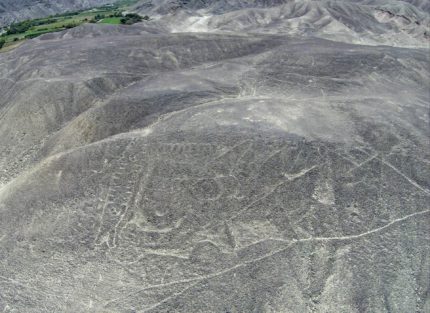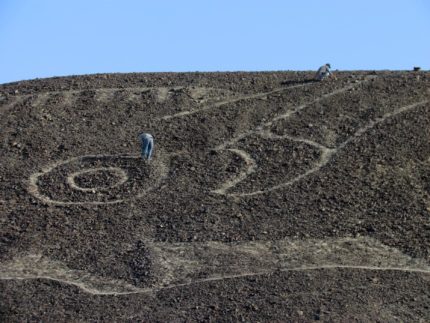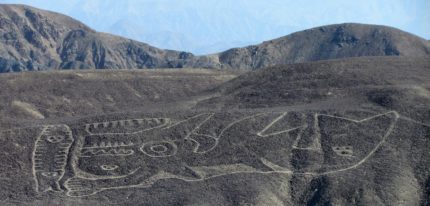The arid desert coast of southern Peru is famed worldwide for its enormous geoglyphs, the abstract, geometric and zoomorphic shapes known as the Nazca lines after the ancient Peruvians who moved rocks to expose the topsoil creating a line-drawing effect when viewed by the aliens who used them as a landing pad. (Sorry about that. I haven’t watched the History channel in years and still the sarcasm flows out of me like honey. Really bitter, eye-rolly honey.) It seems the Nazca’s abilities may have antecedents, however, in another culture that preceded them, and a recently rediscovered geoglyph may hold the key to unlocking the early history of this magnificent art form.
 In the 1960s, German archaeologists discovered a geoglyph of an orca in the Palpa Valley, an area neighboring Nazca in the same Ica region about 250 miles south of Lima. It was photographed at the time but not documented properly so its exact location was lost and nobody could find the enormous killer whale drawn into the side of a hill for 50 years. In 1997, a team of researchers from the German Archaeological Institute’s Commission for Archeology of Non-European Cultures (KAAK) started a project in cooperation with the Instituto Andino de Estudios Arqueológicos (INDEA) to study, map, document and restore all the great line drawings in Nazca and Palpa. There are thousands of geoglyphs in less than hospitable terrain, and when they haven’t been maintained or even seen in decades, they can be hard to track down.
In the 1960s, German archaeologists discovered a geoglyph of an orca in the Palpa Valley, an area neighboring Nazca in the same Ica region about 250 miles south of Lima. It was photographed at the time but not documented properly so its exact location was lost and nobody could find the enormous killer whale drawn into the side of a hill for 50 years. In 1997, a team of researchers from the German Archaeological Institute’s Commission for Archeology of Non-European Cultures (KAAK) started a project in cooperation with the Instituto Andino de Estudios Arqueológicos (INDEA) to study, map, document and restore all the great line drawings in Nazca and Palpa. There are thousands of geoglyphs in less than hospitable terrain, and when they haven’t been maintained or even seen in decades, they can be hard to track down.
 Team leader Johny Isla Cuadrado, head of the Decentralized Office of Culture of the Ica region, saw the old picture of the orca geoglyph in an archaeological catalog published in the 1970s. The description was confused and not specific enough as to the size and find site for Isla to figure out where it might be. When he researched it further, he found the area’s residents had no idea where it was either. He used Google Earth to search for it but it the elements had not been kind and the design was difficult to discern. Well, impossible for any normal human. Archaeologists are special, though, and he was able to pick out clues to possible locations of the geoglyph here and there. Finally he found the long-lost orca the old fashioned way: he tromped the desert hills until he saw it with his own two eyes.
Team leader Johny Isla Cuadrado, head of the Decentralized Office of Culture of the Ica region, saw the old picture of the orca geoglyph in an archaeological catalog published in the 1970s. The description was confused and not specific enough as to the size and find site for Isla to figure out where it might be. When he researched it further, he found the area’s residents had no idea where it was either. He used Google Earth to search for it but it the elements had not been kind and the design was difficult to discern. Well, impossible for any normal human. Archaeologists are special, though, and he was able to pick out clues to possible locations of the geoglyph here and there. Finally he found the long-lost orca the old fashioned way: he tromped the desert hills until he saw it with his own two eyes.
That was January of 2015. This spring, Isla returned with Ministry of Culture experts to clean and restore it so it would again be visible to the untrained human eye instead only satellites and archaeologists who know what to look for. Now their work is done and the geoglyph is back to its former splendor inhabiting the characteristic shape of early Peruvian killer whale iconography.
 About 70 meters (230 feet) long, the orca is unusual in several ways. Its location on a rolling hillside distinguishes it from the Nazca lines which were all more practically placed on flat plateaus. Archaeologists believe this was one of the earliest stages of this type of artwork. It is found elsewhere among the Palpa geoglyphs, while very rarely at Nazca. It seems the successors of the tradition simplified the task by selecting more ideal surfaces. The hilly terrain also makes the older line drawings more susceptible to damage from erosion.
About 70 meters (230 feet) long, the orca is unusual in several ways. Its location on a rolling hillside distinguishes it from the Nazca lines which were all more practically placed on flat plateaus. Archaeologists believe this was one of the earliest stages of this type of artwork. It is found elsewhere among the Palpa geoglyphs, while very rarely at Nazca. It seems the successors of the tradition simplified the task by selecting more ideal surfaces. The hilly terrain also makes the older line drawings more susceptible to damage from erosion.
The creators of the orca drew it on the hillside in negative relief by removing a thin layer of stones to form the outline of the figure. This is similar to the technique used by the people of the Nazca culture to create geoglyphs from about 100 B.C. to A.D. 800.
But some contrasting parts of the rediscovered pattern, such as the eyes, were created out of piles of stones, the researchers said. This technique was used by people of the older Paracas culture, who occupied the region from around 800 B.C. to 200 B.C.
Soil tests have indicated that the orca geoglyph dates from around 200 B.C. The style of the pattern and its location on a hillside, rather than on a plain, suggest that it may be one of the oldest geoglyphs in the region, said one of Isla’s colleagues, Markus Reindel of the German Archaeological Institute, in an interview in a German newspaper.
The Paracas culture, you might recall, produced some of the most exquisite textiles and knits in the ancient world, some of which were used to wrap mummy bundles and survived in extraordinarily vibrant color thanks to the arid climate. They were also innovators in the creation of pottery.
Peru would like to make this remarkable early example of some of its most beloved cultural patrimony accessible to the public, but they can’t because terrible people are terrible and have basically stolen the land using some offensively stupid loophole that allows any grasping greedo to claim huge swaths of state-protected property as “uncultivated lands.” This is a major problem in Peru right now, land traffickers who snatch public land, even in a desert, even covered in priceless ancient art, enclose it and exploit it giving not a rat’s ass about the impact their construction/agriculture/whatever has on the patrimony it abuts.
